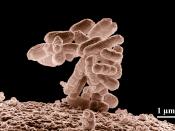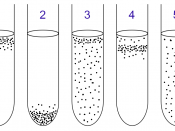Lab study of fermentation of Sauerkraut to explain microbial succession
Figure 1 shows the total plate counts over the six weeks data was collected excluding the 4th week as data was not collected that week. Besides the total colony forming units (CFU) per week for all plates, the graph is also accompanied by a trendline calculated to second degree polynomials. This is important because some of the data points, as seen in Table 1, are missing due to the plates either experiencing no growth, no viable colony counts or overgrowth. Showing the trendlines allows a more broad view of the data, diminishing the effect of the missing data points. For the purposes of this graph, the scale used to express CFU was
Table 1: CFU for the different plates over the five-week period.
Time | Day 0, Week 6 | Day 7, Week 7 | Day 14, Week 8 | Day 28, Week 10 | Day 35, Week 11 | |
pH | 6.5 | 4 | 5.5 | --- | 4 | |
Aerobic | Total | 0 | --- | 5.6x | 5.9x | --- |
HIAS | 0 | --- | 7.0x | 4.7x | --- | |
MAC | 0 | --- | 7.0x | --- | --- | |
MRS | 0 | --- | 1.7x | --- | --- | |
PCA | 0 | --- | 1.1x | 1.2x | --- | |
SAB | 0 | --- | 1.4x | --- | --- | |
Anaerobic | Total | 0 | 8.6x | 4.36x | 9.7x | 2.38x |
HIAS | 0 | 8.5x | 3.6x | --- | 5.7x | |
MAC | 0 | 3.1x | --- | --- | --- | |
MRS | 0 | --- | --- | 3.4x | 8.4x | |
PCA | 0 | 7.7x | 2.5x | 3.0x | --- | |
SAB | 0 | 3.8x | 1.5x | 3.3x | 9.7x |
As clearly seen in the trendlines of Figure 1, compared with the aerobic control, the anaerobic growth experienced a peak over the first week and then a steady decrease as the weeks progressed. This is a clear indication of success for this study as research shows, strains of coliform bacteria proliferate in the initial aerobic environment. Also...


